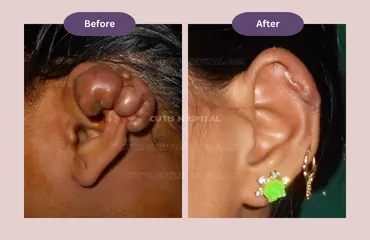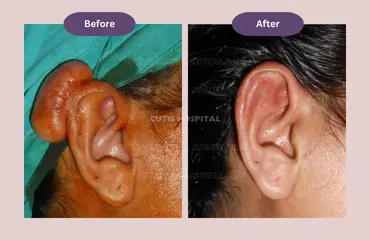A keloid is an over-sized growth of collagen and fibrous tissue developed due to skin trauma. It is genetically inherited and usually affects dark-skinned people. Keloid can outgrow the original scar site and can cause itching, burning, and pain. It affects certain body parts, such as the neck, earlobe, and jawline. Keloids are not harmful and can be removed for cosmetic purposes. Keloid scar treatment involves surgery, steroid injections, laser treatments, Cryosurgery, and radiation.
Keloids require multiple treatment methods to reduce the possibility of recurrence. A newly formed keloid can be controlled with silicone sheet dressing, massage, and compression.
For older keloids, laser therapy can improve symptoms, soften, and decrease their vascularity. While, corticosteroids injections can shrink and soften the keloid. For improved results, steroid injections combined with fluorouracil (5-FU) is required. Cryosurgery is another effective Keloid scar treatment.
Skin injury may cause keloid scarring, such as, chickenpox scars, surgical incision areas, burns, scratches, acne scars, vaccination areas, and ear piercing.
Studies indicate 10% of population including both men and women experience keloid scarring. Individuals with darker skin, pregnant women, Asian and Latin people, and individuals below 30 years are more susceptible to keloids. It’s a genetically inherited scar, so if both or either of your parents have keloid, you are mire likely to have it.
Matured keloids are less responsive to laser treatments and are managed with Keloid removal surgery and therapies. A corticosteroid injection is given prior to the surgery to minimize surgical trauma and prevent its recurrence. Once the keloid is removed regular therapy such as compression, radiation, and silicone is required to heal the scar.
Cryosurgery is highly effective Keloid scar treatment. The process involves freezing the keloid with liquid nitrogen.
Keloid removal surgery seems a permanent solution but it’s essential to know that 100% of keloids re-occur post-surgery. To reduce the chance of recurrence, patients should either opt for cryosurgery or regularly take corticosteroid injections before the surgery.
Immediate result is seen post Keloid removal surgery. The scar left after the keloid removal is smaller, and with follow-up care, it stays flat and small, and eventually fade. Post the surgery, the sutures remain intact and are removed after a week. During the post operative care, patients must keep the area clean and avoid strenuous exercises including heavy lifting. Although patients can return to school or work next day post-surgery but most of them return to their regular activities within 1-2 weeks.
Keloid removal surgery requires high precision and superior care to prevent its recurrence. Our team of Cosmetic surgeons and post-surgery care team possess relevant experience to deliver aesthetically appealing results. We use a combination of surgical and non-surgical treatment methods to maintain the results post-surgery.



A doctor will operate on the keloid under local anesthesia. An incision is made on the keloid scar to dissect and remove the keloid from underneath the skin. Excess skin created due to an enlarged scar is also removed. The wound is sutured and a flat scar is formed that fades away within a few weeks. Further, during the healing period, steroid injections are administered to patients to prevent its recurrence.
For keloid and scar treatment, you should discuss the available options with your cosmetic surgeon. The treatment involves both surgical and non-surgical procedures. If the removal requires surgical intervention, then additional preparation is needed, which will be discussed by your doctor.
No, Keloid removal surgery is performed under local anesthesia. Since the area gets numb, you won’t feel any pain. However, mild pain after the surgery is normal, and it can be controlled with over-the-counter medications.
The surgery is permanent but involves an inherent risk of recurrence. To minimize this risk, surgical excision is often combined with non-surgical treatment such as radiation, and steroid injections given before, during, or after the surgery,
Yes, the procedure is safe. However, the general risks associated with all types of surgery cannot be ignored. These risks involve bleeding, pain, and infection. However, your doctor will guide you for the post-operative care. In case you experience any of these symptoms immediately consult your doctor.
Cutis Hospital is conveniently located in Ghatlodia, Ahmedabad, making it easily accessible via multiple modes of transportation. Below are the various ways you can reach our facility:
Sardar Vallabhbhai Patel International Airport: Located approximately 12.7 km from Cutis Hospital, offering convenient access for patients traveling from outside the city.
Chandlodiya Railway Station: Approximately 2.4 km from Cutis Hospital.
Ahmedabad Railway Station: Around 11 km from our center.
GSRTC:
Ahmedabad Central Bus Station (GSRTC): About 10.3 km from the hospital.
AMTS:
Bhuyangdev Cross Road Bus Stop: Just 500 meters from Cutis Hospital.
BRTS:
Bhuyangdev BRTS Bus Stop: Only 170 meters from our center.
We provide effective surgical and non-surgical treatments for all parts of the body. At Cutis Hospital, our cosmetic and plastic surgery team is committed to giving patients safe and high-quality care.